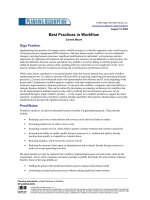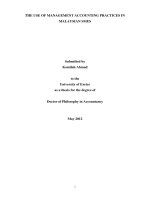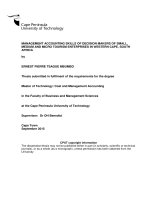Contemporary management accounting practices in UK manufacturing by david dugdale and stephen green
Bạn đang xem bản rút gọn của tài liệu. Xem và tải ngay bản đầy đủ của tài liệu tại đây (861.74 KB, 247 trang )
Contemporary Management
Accounting Practices in UK
Manufacturing
David Dugdale
Department of Accounting and Finance
University of Bristol
T Colwyn Jones
School of Sociology
University of the West of England, Bristol
Stephen Green
Bristol Business School
Home Group Limited
AMSTERDAM • BOSTON • HEIDELBERG • LONDON
NEW YORK • OXFORD • PARIS • SAN DIEGO
SAN FRANCISCO • SINGAPORE • SYDNEY • TOKYO
CIMA Publishing is an imprint of Elsevier
CIMA Publishing
An imprint of Elsevier
Linacre House, Jordan Hill, Oxford OX2 8DP
30 Corporate Drive, Burlington, MA 01803
First published 2006
Copyright © 2006, David Dugdale, T Colwyn Jones and Stephen Green. All rights reserved
The rights of David Dugdale, T Colwyn Jones and Stephen Green to be identified
as the authors of this work has been asserted in accordance with the Copyright,
Designs and Patents Act 1988
No part of this publication may be reproduced in any material form (including
photocopying or storing in any medium by electronic means and whether
or not transiently or incidentally to some other use of this publication) without
the written permission of the copyright holder except in accordance with the provisions
of the Copyright, Designs and Patents Act 1988 or under the terms of a licence issued by
the Copyright Licensing Agency Ltd, 90 Tottenham Court Road, London, England W1T 4LP.
Applications for the copyright holder’s written permission to reproduce any part of
this publication should be addressed to the publisher
Permissions may be sought directly from Elsevier’s Science and Technology Rights
Department in Oxford, UK: phone: (ϩ44) (0) 1865 843830; fax: (ϩ44) (0) 1865 853333;
e-mail: You may also complete your request on-line via
the Elsevier homepage (), by selecting ‘Customer Support’ and
then ‘Obtaining Permissions’
British Library Cataloguing in Publication Data
A catalogue record for this book is available from the British Library
Library of Congress Cataloguing in Publication Data
A catalogue record for this book is available from the Library of Congress
ISBN-10:
ISBN-13:
0-7506-6871-7
978-0-7506-6871-2
For information on all CIMA Publishing Publications
visit our website at www.cimapublishing.com
Typeset by Integra Software Services Pvt. Ltd, Pondicherry, India
www.integra-india.com
Printed and bound in Great Britain
06
07
08
09
10
10
9 8 7 6 5 4 3 2 1
Working together to grow
libraries in developing countries
www.elsevier.com | www.bookaid.org | www.sabre.org
To Andrew and Ang
This Page is Intentionally Left Blank
Contents
Executive Summary
ix
1
Introduction
1
2
Literature Review and Historical Context
2.1
2.2
2.3
2.4
3
Methodology
Origins of the project
The initial pilot companies
The secondary pilot companies
The main study
A concluding note on methods
The Presentation of Financial Information:
The Definition of “Contribution Margin”
4.1 Introduction
4.2 Issues of terminology
4.3 “Contribution companies”: The definition of
contribution
4.4 Changing financial systems in “Contribution”
companies
4.5 The presentation of financial results and
the “Relevance Lost” thesis
5
Standard Costing and Variance Analysis
5.1
5.2
5.3
5.4
5.5
5.6
5.7
5.8
Introduction
Analysis of companies not employing standard costs
The content of standard costs
The inclusion of standard costs in the profit
and loss account
The use of variance analysis
The purposes of standard costing
Changing financial systems in standard costing
companies
Concluding comments
9
11
12
37
47
55
57
58
62
63
68
Contents
3.1
3.2
3.3
3.4
3.5
4
Introduction
A brief history of costing
Relevance lost and regained: Recent developments
Cost accounting practice in the 1990s
v
69
71
72
76
79
81
83
85
86
89
90
94
98
102
103
6
Interaction of Profit Reporting and Costing
Systems
Contents
6.1 Introduction
6.2 The contribution concept combined with standard
costing
6.3 The contribution concept combined with actual costing
6.4 The gross profit/margin concept combined with
standard costing
6.5 The gross profit/margin concept combined with
actual costing
6.6 Companies not easily classified as primarily
contribution or gross margin oriented
6.7 Conclusions: Margins, variances, costing systems
and “Relevance Lost”
7
The Treatment of Overhead Costs
7.1 Introduction
7.2 Treatment of manufacturing overhead in internal
financial reporting by companies employing
contribution concepts
7.3 Treatment of manufacturing overhead in internal
financial reporting by companies employing gross
profit concepts
7.4 The analysis of overhead for responsibility, product
or segmental reporting
7.5 Activity-based costing
7.6 Influences on choice of reporting system
vi
8
Budgets, Forecasts and Performance Evaluation
8.1
8.2
8.3
8.4
Introduction
Budgeting
Forecasting
Making sense of financial performance: Segmental
and comparative analyses
8.5 Performance measurement and remuneration
8.6 Conclusion
9
Conclusion
9.1 Introduction
9.2 Overview of research findings
9.3 The “Relevance Lost” view of management
accounting history
105
107
108
115
117
120
121
122
127
129
130
135
138
146
151
157
159
159
161
168
173
177
179
181
182
190
10
Recommendations
10.1 Introduction
10.2 Changing practices: Issues for reflection
10.3 Research implications
195
197
198
203
References
209
Subject Index
221
Author Index
227
Contents
vii
This Page is Intentionally Left Blank
Executive Summary
Research methods
This book deals with the presentation and analysis of financial
information in the 41 UK manufacturing companies. The research
was stimulated by a previous investigation that unexpectedly
revealed that a number of manufacturing companies present
financial information in contribution format rather than in the
“gross margin” style consistent with financial reporting requirements. A pilot study confirmed that a number of companies use
contribution statements in their internal financial reporting.
However, initial company visits also revealed considerable variation in terminology and much scope for misinterpretation of practice. To combat this, companies participating in the main study
were asked to provide pro forma Profit and Loss (P&L) accounts
and these were analysed and provided the basis for follow-up
structured interviews. The pro forma P&L formats together with
short summaries of practice and company overviews are set out in
the Appendix (supplied on CD) to this report.
Our document-based interviewing method has a number of advantages. First, the information presented is likely to be faithful to
reporting practice in participating companies at the time of the
study. Respondents were invited to check the interview summaries
and discussion in the main report can be checked against the P&L
Executive Summary
Contemporary Practices in UK Manufacturing Accounting – a
CIMA research project – reveals methods currently used for reporting financial information in UK manufacturing companies. Based
on 41 companies, it shows a rich diversity of reporting practices
that are constrained neither by the financial accounting requirements of SSAP9 nor by any sense of general management accounting trends. Instead, Financial Directors choose from a toolkit of
“traditional” and “contemporary” practices in constructing reporting systems appropriate to their varied commercial needs, but with
a strong leaning towards contribution margin approaches. These
choices cover a wide range of reporting practices in relation to contribution, margin, profit, variances, budgets and forecasts.
ix
layouts and summaries in the Appendix. Second, the combination
of documentary evidence and interviews helps avoid inferring
researchers’ meanings rather than those actually intended by practitioners. Third, where interesting accounting methods are adopted
in companies, these could be pursued and set out in greater depth.
Executive Summary
The disadvantage of document-based interviewing is the commitment required from firms and only about 9% of companies contacted were willing to participate in the study. Thus, validity is
achieved at the expense of representativeness but, in our view, the
results strongly justify this trade-off.
x
Costing techniques
The study reveals that virtually all the techniques developed since
the late nineteenth century, and evident in the historical literature,
are still in use today. There are examples of “traditional” techniques such as absorption costing, standard costing and marginal
costing as well as “contemporary” techniques such as activitybased costing and throughput accounting. New techniques are
often marketed by denigrating existing methods, identifying them
as “problems” before unveiling new techniques as the “solution”.
For example, standard costing was once hailed as more effective
and much less expensive than the “job-order cost plans” of the
early twentieth century. Direct costing was sold as simpler and
more informative than absorption costing. Activity-based costing
promised to be more accurate and to avoid the misleading signals
of traditional costing methods. However, “old” methods have not
died: they are still taught, examined and used.
Prevalence of contribution statements in internal
financial reporting
In the report, participating companies are broadly categorised as
“contribution companies” or “gross margin companies”. This was
not easy because of ubiquitous references within companies to
“gross profit”, “gross margin” and “manufacturing margin” applied
to P&L lines that textbooks would refer to as “contribution margin”.
However, we conclude that 28 (approximately 68%) of the survey
companies employ contribution statements. All these companies
treat material cost as variable and 21 companies (75%) treat labour
as a variable cost. Other “variable” costs appear less frequently:
variable production overhead in 12 companies; transport/distribution costs in 7 companies and variable selling costs in 3 companies.
Prevalence of standard costing but limited
variance analysis
Although not necessarily appearing in the P&L, most of these
companies calculate some material and labour variances for control purposes. Overhead variances are less prevalent and only one
company reports subdivisions of both variable and fixed overhead
variances. No company subdivides the fixed overhead volume
variance into capacity and efficiency elements. Variance reporting
is therefore very selective.
Inter-relationships between financial presentation
and costing systems
Financial reporting presentation and costing methods are interrelated and most of the 28 “contribution companies” make a P&L
adjustment for “overhead in stock” that allows “bottom line”
P&L to be reported on a full cost basis. Surprisingly, 11 of these
“contribution companies” establish “full” standard costs in order
to value stock consistent with financial reporting requirements. In
these companies a contribution orientation is loosely coupled with
Executive Summary
Most (29) of the 41 companies employ standard costs and, of those
that do not, 8 have only limited manufacturing operations or are
engaged in contract work. Therefore only 4 companies (less than
10%) do not employ standard costing where this might be
expected. All (29) “standard costing companies” set standards for
materials, most (26) set standards for labour and about two-thirds
(20) set overhead recovery rates. However, standard cost variances
often do not appear as part of P&L information. Over half of these
“standard cost companies” base P&L reports on actual costs; some
“add back” variances while others frequently update material
standards so that they approximate actual costs.
xi
Executive Summary
a full standard cost system. In “gross margin” companies, systems
are usually more tightly coupled: 7 companies adopt a gross margin approach and, consistently, adopt full standard costing.
xii
Contribution companies can trace variable costs to products or
product groups and, in some companies, this analysis provides
the starting point for further analysis of segment profitability,
attributing overhead to products, markets or distribution channels. This is reminiscent of activity-based ideas and several companies had experience of activity-based costing, usually intended
to establish more accurate product costs. However, although oneoff ABC exercises had provided some valuable insights, none of
the survey companies were currently using the technique.
Choice of financial reporting and costing systems
Senior managers could influence the choice of policy and it was
clear that, in some companies, the finance director or financial
controller had sufficient influence to determine the choice of
system. The choices of these managers were influenced by their
experiences and two senior managers ensured that conservative
(marginal) methods were employed for stock valuation. Financial
controllers tended to prefer marginal methods because of their
simplicity and utility. In several companies, parent company policies could be very important either directly or through their influence on technology choice; several companies had harmonised
their systems with the wider group and/or planned to update their
MRP systems. The nationality of the parent company could also
be a factor and, for example, we noted some similarity in the
reporting adopted by companies under Gallic ownership.
Budgeting and forecasting
All but one of the companies sets budgets and reports budget variances and most companies make regular forecasts. Most forecasts
are for the financial year, typically referred to as, for example,
“3 ϩ 9” or “6 ϩ 6” forecasts. The concentration on financial year
reporting reveals the influence of external pressures and, at one
company, current and previous year results are compared: “. . .
because that’s the way the stock market seems to work”. One company is exceptional in developing its forecasts to include the
remainder of the current financial year and the whole of the following year. This development, including innovative graphical
presentations, is set out in detail in the Appendix.
Incentive schemes
Most of the companies operate either executive or staff incentive
schemes and 13 operate both.
The staff schemes also rely heavily on financial measures. Although
non-financial measures such as on-time delivery, customer feedback and quality are occasionally employed, relatively few companies use these measures.
About half of all incentive schemes are based on a single performance measure. The remainder use combinations of measures and,
in a few schemes, there are as many as four measures in combination. Although financial measures are prevalent these are not particularly sophisticated, only three of the executive schemes use
return on capital employed and none use residual income or its
more modern version, economic value added.
The “relevance lost” debate
A loud critique of management accounting over the last 20 or so
years is that it has lost its managerial relevance through subservience to the requirements of external financial accounting. If
so, in the UK, this would mean that SSAP9 acts as a strong constraint on internal financial reporting. This survey undermines
this view. Instead, we find a wide range of practices that are constructed in response to the particular commercial circumstances
of individual companies and not imposed by an external financial
Executive Summary
The executive schemes have a heavy reliance on financial performance measures and over half of the companies (10 from 18)
use profit versus budget or target in their schemes. The most
important non-financial item in these schemes is “personal performance”.
xiii
accounting regime. Thus there are very varied practices in UK
manufacturing companies. The survey companies employ:
Executive Summary
marginal costing and contribution ideas;
standard costing but often combined with reports based on
actual costs;
variance analysis but limited use of overhead variances;
segmental reporting;
budgeting, forecasting and incentive schemes.
xiv
Companies have a wide range of options in order to ensure that
their systems are “relevant” and the majority of the survey companies had opted for direct or marginal costing.
The number of companies employing contribution methods and, to
a greater or lesser extent, marginal costing, suggests that manufacturing companies in general are not dominated by the (full cost)
requirements of financial reporting standards. However, matters
are not quite this simple. We note that the bottom line P&L in most
companies is reported in accordance with SSAP9 and although,
technically, it is easy to report both marginal and full cost P&L,
only one company does this. Additionally, companies employ
cycles of budgeting and forecasting that are clearly influenced by
external financial reporting requirements. We conclude that, in
many companies, financial reporting does not lead to the inappropriate use of full product costs. However, internal financial reporting is often influenced by external reporting cycles, and managers
are conscious of the need to meet external expectations.
Issues for reflection
There is considerable interest in contribution analysis in the companies studied. Although there has been a widespread presumption
that absorption costing systems dominate manufacturing practice
this study reveals that companies often follow long-standing
academic advice in structuring their internal P&L reporting on
contribution lines. However, the analysis is sometimes not very
systematic – for example, only one company derives both marginal and full cost profit on a month-to-month basis. There is
scope for the more systematic application of marginal cost principles and contribution reporting.
Manufacturing companies usually employ standard costing systems. However, they tend to be selective in their use of variance
analysis, and analysis of overhead variances was very limited.
These practices may reflect the widespread criticism that the
(mis)use of variance analysis has received, especially in JIT and
TQM environments. Companies using variance analysis need to
be aware of the limitations of the technique.
There is extensive use of budgeting, forecasting and incentive
schemes but the methods adopted are, typically, relatively unsophisticated. For example, most companies make forecasts only at
the end of the financial year and employ a very limited range of
performance criteria in their incentive schemes. Forecasting systems could be extended so that a rolling twelve-month forecast is
routinely available and further research into the design, use and
impact of incentive schemes would be desirable.
Executive Summary
Interviewees were generally very conscious of the arguments for
and against the apportionment and allocation of overhead to cost
objects such as divisions, responsibility centres, products and
services. However, some companies employed quite sophisticated
segmental profitability analysis based on the thoughtful attribution of overhead. This was especially so in contribution companies because the contribution line provides a sound starting point
for such analysis. Companies adopting contribution style presentations can add value to the presentation by identifying levels of
contribution. Contribution calculated after variable costs and after
sales and marketing costs by market, distribution channel or customer can be especially valuable for some companies.
xv
This Page is Intentionally Left Blank
1
Introduction
This Page is Intentionally Left Blank
Originally this thesis was specifically related to US manufacturing,
but it quickly became generalized to other countries and organisations, and the 1990s saw a busy marketplace for a wide variety of
new management accounting theories and practices. In part this
was fuelled by expansion of management consulting activity with
consultants being hungry for new accounting packages to market to
managers uncertain about the efficacy of their existing accounting
systems. For example, PricewaterhouseCoopers and KPMG promoted Activity-based Costing/Management (ABC/ABM), Stern
Stewart trademarked Economic Value Added as EVA™, and the
Goldratt Institute produced Throughput Accounting (TA).1 Each
promised an holistic approach to reforming accounting systems
to provide more accurate and/or more relevant information for
management.
The adoption of such new accounting forms was tracked by a
series of questionnaire surveys that showed, by the early 1990s,
around 20% of the largest UK companies claiming to have
1The
latter usually referred to in the UK as Theory of Constraints in accounting.
Contemporary Management Accounting Practices
Following the publication of Johnson and Kaplan’s (1987) critique
of management accounting in which they claimed that, in the US
case, management accounting had long lost its relevance for management decision making, there has been considerable academic
interest in the development and diffusion of “new” management
accounting theories and practices. The original critique was stimulated by an analysis that identified a deep malaise in US industry
that meant it was struggling in the face of an unprecedented wave
of new opportunities and threats in a “new manufacturing environment” (Armstrong, 2002; Jones and Dugdale, 2002). American
manufacturing was portrayed as increasingly located in a global
market, under challenge from international (especially Japanese)
competitors, and failing to make effective use of new management
techniques and advanced manufacturing technology. The analysis
identified the cause of the malaise in inadequate or misleading
management information resting on a failure of managerial expertise, and of calculative expertise in particular (Miller and O’Leary,
1993) leading to a crisis of confidence in management accounting
(Dent, 1990).
3
Contemporary Management Accounting Practices
4
implemented ABC systems (Innes and Mitchell, 1995b). This figure rose to 60% when those claiming intentions to experiment
with ABC were included, with a further 40% of UK firms claiming
to be using, or planning to use, TA (Bright et al., 1992). This
would appear to indicate widespread innovation in UK business.
There are, however, some doubts about the meaning and validity
of these claims and Bright et al. note that the figures produced by
their questionnaire:
did not conform to our own observations . . . [and] many managers were willing to debate the advantages and disadvantages of
different “advanced” techniques and practices with only a very
tentative understanding of what the terms embraced and
involved. (1992, p. 204)
Thus practitioners’ claims to be using new techniques need to be
treated with caution and documentary evidence is important in
confirming; first, that such techniques are actually in use and, secondly, the nature of these techniques.
Another issue is problematic in researching “contemporary”
accounting practice with its implication that contemporary practice differs from previous practice. Typically, new developments
are accompanied by doubts about whether anything on offer is
really “new”. The introduction of ABC in the late 1980s could be
seen as a reformulation of the “functional costing” that had
appeared in Longman and Schiff’s (1955) Practical Distribution
Cost Analysis (Horngren, quoted in Robinson, 1990: p. 23).
Similarly EVA™ may be seen as a variety of the “residual income”
approach; and TA as a rediscovery of “contribution-per-unit-oflimiting-factor”. Thus “new” management accounting systems
might recycle long-standing theories and practices having their
origins far back into the twentieth century. Armstrong claims that
the argumentation style of those proposing management accounting systems typically involves appeals to managerial common
sense – drawing upon what is already known – and thus these
systems must reflect what is already accepted: “It is mode of evolution in which innovation consists of catching up with what
business commonsense already ‘knows’ ” (1995, p. 16). Certainly
the debates between rival supporters of the absorption costing version of ABC and the direct costing of TA in the 1980s and 1990s
One might ask, then, what to count as innovation in management
accounting? The verb “to innovate” may be defined as “to introduce as something new” (Chambers Dictionary). Absolute innovation may thus be seen as the introduction of something that has not
existed before; something entirely novel. At one extreme, such
novelty might be defined as a fundamental departure from preexisting accounting theories and practices but, if so, then it may be
impossible to discover any such “paradigm shift” (Kuhn, 1962) in
management accounting. Indeed, Kuhn (1970) himself doubts
whether such paradigm analysis can be applied in the social sciences and, in this respect, we may find management accounting to
conform with this pattern. At the other extreme, if any repackaging
or relabelling of existing accounting is taken as innovatory, then
minor or cosmetic amendment may be mistaken for significant
substantive change. However, for accountants and managers who
are actually engaged in changing their accounting systems, such
distinctions may not be highly relevant. Instead, what is of significance is relative innovation in which practitioners are introducing
different systems that are new in relation to the recent experiences
of either the individuals or of the companies involved. In designing and implementing such systems in the particular contexts of
current circumstances such individuals and companies are innovating – regardless of whether other individuals and companies, in
different circumstances, have followed similar paths before. In
addition to such changes, some of what may be regarded as innovation may properly be seen as practices that diverge from those
expected even though they may have been in place in particular
companies for some time. They are in this sense new to the
Contemporary Management Accounting Practices
rehearsed arguments that were well covered in similar battles
between absorption costers and direct costers in the UK in the
1950s and 1960s (Dugdale and Jones, 2003). These, in turn,
echoed disputes in the early years of the century. Garcke and
Fells’ (1887) textbook advocated a form of what, today, would be
identified as “marginal” costing (Boyns and Edwards, 1997a) but
in the textbooks of the 1920s and 1930s it was absorption costing
that had acquired theoretical hegemony (Glover and Williams,
1928; Wheldon, 1937; Carter, 1938). Many of today’s “new” management accounting practices may thus be seen as “re-inventing
the wheel”.
5
Contemporary Management Accounting Practices
observer, even if they are familiar to the practitioner. All of these
conceptions of innovation have informed our study of contemporary management accounting practices.
6
The study was stimulated by exploratory work in six companies
where the initial focus was upon approaches to pricing and the
roles of management accountants and marketers in pricing decisions. This involved investigation of internal reporting processes
because of the potential interaction between costs, margins and
prices. To the researchers’ surprise it was clear that internal
reporting in some of the companies visited had undergone significant change in recent years. First, none of the companies placed
much emphasis on the calculation or reporting of variances
against production cost standards. And, second, three of the six
companies did not adopt the traditional profit and loss format.
Instead of deducting cost of sales from revenue to establish gross
margin they deducted production variable costs and market/
business segment related costs to establish “contribution” from
each business unit or segment. Manufacturing and general overhead was then deducted in order to establish net profit.
In one innovative company both activity-based and throughput
ideas had been integrated into standard internal reporting. The
managing director of the company referred to throughput (although
he could not remember where he heard the term) defining it as
sales less material cost of sales. “Throughput” was calculated for
each business sector and then marketing and directly attributable,
transaction related, product and customer costs were deducted to
establish “segmental contribution”. This seemed rather sophisticated, combining the reporting of activity-based transaction-related
costs (in marketing and distribution) with ideas from throughput
accounting. The internal reports reflected the company’s new
organisation structure by providing information to the managers
responsible for sales in the two key business segments.
Nevertheless the managing director of the company was still dissatisfied with the management accounting system. His latest intent
was to develop a more dynamic set of reporting standards drawing
ideas from the “beyond budgeting” and “throughput” literatures.
The accounting practices adopted in this company, and those
observed in the other companies during the exploratory research,
led to the identification of manufacturing accounting innovation as
This monograph reports the CIMA Contemporary Practices in UK
Manufacturing Accounting project.2 The aim of the project was to
investigate internal management accounting reports in UK manufacturing companies. The study investigated whether the development of new theory-based techniques, changes in organizational
contexts, differing perceptions, values and interests of management accountants, and other factors have led to change in the
presentation of financial information.
The project had three specific objectives:
1. to investigate whether internal management accounting policies and reporting are currently dominated by the requirements
of financial reporting;
2. to establish the nature of innovatory forms of management
information and begin to explore where and why they have
been introduced;
3. to disseminate innovative practice in management accounting.
The research disclosed a highly varied range of practices in companies. Whilst the external influences of financial reporting,
through auditing and in anticipation of International Accounting
Standards, was present, it did not dominate management information. Rather than the traditional absorption costing that might be
anticipated in manufacturing, the use of contribution margin was
found to be widespread. Although the availability of computer
software accounting practices might suggest some degree of standardization, the particular practices adopted varied considerably
between companies that differed in terms of their products, production methods, markets and forms of ownership – with the
impact of foreign ownership being marked. The adoption of such
2Originally
titled the CIMA Innovation in Manufacturing Accounts project. The title
was eventually changed so that readers would not be misled as to the content of
the report.
Contemporary Management Accounting Practices
an important issue for investigation. If the innovatory practices
found in the small sample of companies were widespread, then it
would be evidence of a rehabilitation of management accounting
following Johnson and Kaplan’s (1987) charge of Relevance Lost –
or, possibly, that this charge was never plausible in the UK.
7
Contemporary Management Accounting Practices
8
practices was rarely influenced by management consultants and,
instead, represented individual decisions within companies that
were heavily influenced by the personal experiences and preferences of key managers and accountants. Hence, accounting practices were generated and reproduced through varied social action
in varied social contexts. This means that, other than a general
interest in contribution accounting, there is no clear direction or
“evolution” of manufacturing accounting practice. Indeed, in
some cases, one company may be adopting a particular practice at
the same moment that another is abandoning it. What the companies hold generally in common, however, is that they have room
for manoeuvre in determining their management accounting practices, since these are not dictated by financial reporting
requirements.
The remaining chapters of this report are structured as follows:
◆ Chapter 2 reviews research into the development of management accounting, prescriptions for new forms of accounting,
and surveys of contemporary practice.
◆ Chapter 3 lays out the methods employed in studying the 41
companies.
◆ Chapter 4 reports the Profit & Loss Account reporting conventions adopted.
◆ Chapter 5 deals with the nature and use of costing and variance
analysis.
◆ Chapter 6 deals with issues of integrating the techniques discussed in the previous two chapters.
◆ Chapter 7 covers the treatment of overhead costs.
◆ Chapter 8 covers budgets, forecasts, performance measurement
and reward.
◆ Chapter 9 draws together our overview of contemporary forms
of manufacturing accounting.
◆ Chapter 10 concludes with a review of the theoretical and practical implications of our study for researchers and practitioners.









